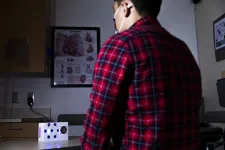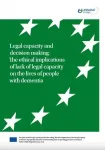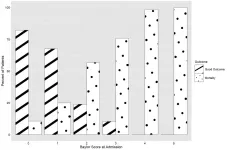Researchers grow most lifelike bone yet from woven cells
First organoid for bone will greatly increase understanding of bone formation and bone diseases
2021-03-09
(Press-News.org) Imagine using stem cells from your bone marrow to grow a piece of bone tissue in the lab, after which medical doctors explore which drugs have the desired effect on your bones. In this way, a tailor-made treatment plan would be made for everyone, with the best approach being clear in advance. Personalized medicine at its best.
That vision of the future is no longer science fiction now that researchers from Eindhoven University of Technology and Radboud university medical center have actually realized the first part: growing a lifelike piece of bone tissue from human stem cells. It is the first organoid of bone, a simplified version of the original, the researchers report today in the journal Advanced Functional Materials.
Coherent picture
"With this, we present, for the first time, the full picture of early-stage bone formation," says Sandra Hofmann, associate professor in Bioengineering Bone from TU/e. And that is of great importance: how our bones are formed is still largely a mystery. Bone is a very complex material in which, on the one hand, countless cells and processes interact and, on the other hand, an ingenious matrix of collagen and mineral is built up to provide strength. Much is known about the individual components, but a coherent picture has been lacking until now.
Three types of cells play the main role in bone formation: osteoblasts (which build bone tissue), osteoclasts (which take bone away) and osteocytes (which regulate the building and breaking down of bone). "Most studies so far have focused on one of these types of cells, but that is not a good representation of the real tissue," says Hofmann. "We present here a piece of woven bone (early-stage bone) that developed from stem cells and contains two types of these cells: osteoblasts and osteocytes. We now see that we can make lifelike bone exclusively with these two cell types."
Getting wiser from molecular poking
"And perhaps more importantly, our system behaves just like early-stage bone ", says Anat Akiva, assistant professor Cell Biology at Radboudumc. "We show that both types of cells produce the proteins that they need for their functionality, and we show with the greatest detail that the matrix actually is the bone matrix we see in real tissue."
The fact that a simplified representation of the formation of bone at the molecular level is now possible offers unprecedented possibilities, according to the researchers. "A bone consists of 99% collagen and minerals, but there is also another 1% of proteins that are essential for successful bone formation," explains professor Nico Sommerdijk from Radboudumc. "So what's the role of these proteins? How do they support bone formation? Never before have we been able to look at the milestones of this process at a molecular level."
And with that, they immediately have a good entrance to investigate the cause of genetic bone diseases such as "brittle bone disease" and their possible treatments. "Remember that the origin of many diseases is at the molecular level - and so is the treatment," says Akiva. "In fact, we now have a simple system in a reliable environment in which we can poke around and see how bone cells react to the stimuli we provide."
INFORMATION:
ELSE PRESS RELEASES FROM THIS DATE:
2021-03-09
Smart speakers, such as Amazon Echo and Google Home, have proven adept at monitoring certain health care issues at home. For example, researchers at the University of Washington have shown that these devices can detect cardiac arrests or monitor babies breathing.
But what about tracking something even smaller: the minute motion of individual heartbeats in a person sitting in front of a smart speaker?
UW researchers have developed a new skill for a smart speaker that for the first time monitors both regular and irregular heartbeats without physical contact. The system sends inaudible sounds from the speaker out into ...
2021-03-09
Nanoengineers at the University of California San Diego have developed a "wearable microgrid" that harvests and stores energy from the human body to power small electronics. It consists of three main parts: sweat-powered biofuel cells, motion-powered devices called triboelectric generators, and energy-storing supercapacitors. All parts are flexible, washable and can be screen printed onto clothing.
The technology, reported in a paper published Mar. 9 in Nature Communications, draws inspiration from community microgrids.
"We're applying the concept of the microgrid to create wearable systems that are powered sustainably, reliably and independently," said co-first author Lu Yin, a nanoengineering Ph.D. student ...
2021-03-09
Charcot-Marie Tooth disease is the most common hereditary neurological disease in the world. It affects the peripheral nerves and causes progressive paralysis of the legs and hands. No treatment is currently available to fight this disease, which is due to the overexpression of a specific protein. Scientists from the CNRS, INSERM, the AP-HP and the Paris-Saclay and Paris universities have developed a therapy based on degrading the coding RNA for this protein in mice. Their work is patented and was published on 9 March 2021 in Communications Biology.
In molecular biology, transcription is when a DNA molecule is copied to make an RNA molecule. This RNA molecule is then "translated" into a protein, which can perform different functions within the body's cells. When a specific protein called ...
2021-03-09
Modern hospitals and antibiotic treatment alone did not create all the antibiotic resistant strains of bacteria we see today. Instead, selection pressures from before widespread use of antibiotics influenced some of them to develop, new research has discovered.
By using analytical and sequencing technology that has only been developed in recent years, scientists from Wellcome Sanger Institute, University of Oslo and University of Cambridge have created an evolutionary timeline of the bacterium, Enterococcus faecalis, which is a common bacterium that can cause antibiotic resistant infections in hospitals.
The results, published today (9th March 2021) in Nature Communications ...
2021-03-09
An increase in overall hospitalizations was reported for older adults in the week following exposure to a tropical cyclone, according to a new study by researchers at Columbia University Mailman School of Public Health, Columbia University's Earth Institute and colleagues at Colorado State University and Harvard T. H. Chan School of Public Health.
The researchers used data over 16 years on 70 million Medicare hospitalizations and a comprehensive database of county-level local winds associated with tropical cyclones to examine how tropical cyclone wind exposures ...
2021-03-09
Luxembourg, 9 March 2021 - Today, Alzheimer Europe launches a new report, "Legal capacity and decision making: The ethical implications of lack of legal capacity on the lives of people with dementia", which looks at the intersection between legal rights and ethical considerations in relation to legal capacity and decision making.
The working group responsible for the report was set up by Alzheimer Europe in 2020 and was composed of experts in dementia, law, ethics, policy, research, psychology and the experience of having dementia and supporting people with ...
2021-03-09
MUNICH -- Around the world each year, extreme precipitation events cause catastrophic flooding that results in tragic loss of life and costly damage to infrastructure and property. However, a variety of different weather systems can cause these extreme events, so a detailed understanding of the atmospheric processes that lead to their formation is crucial.
Now, for the first time, a global analysis reveals that two intertwined atmospheric processes drive the formation of many large-scale extreme precipitation events around the world, particularly in dry subtropical regions where they can inflict catastrophic flooding, as occurred in March 2015 in the Atacama Desert.
Previous research on extreme precipitation events ...
2021-03-09
CHAMPAIGN, Ill. -- A six-week training program designed to strengthen resilience against emotional distress in military veterans was associated with positive changes in brain function and increased confidence in their ability to regulate emotions, researchers report.
Published in the journal Frontiers in Psychology, the new proof-of-concept study tested two approaches for building emotional resilience in 19 veterans. The first involved weekly, 90-minute group therapy sessions focused on sharing and skills-building in 10 participants. The second trained nine veterans in the use of specific emotion-regulation strategies that previous ...
2021-03-09
CHARLOTTESVILLE, VA (MARCH 9, 2021). In 2014, the Journal of Neurosurgery published a paper by a group of researchers from Baylor College of Medicine in Houston, who developed a prognostic scoring system for use in patients who present to the emergency department with a gunshot wound to the head (GSWH).[1]
Today, we publish two papers by a group of researchers at Vanderbilt University Medical Center that extend our understanding of the Baylor GSWH scoring system and its application, externally validating it in a different group of patients presenting during a more recent time period in which ...
2021-03-09
People living with a patient undergoing an intensive weight loss treatment also benefit from this therapy. This has been demonstrated by a team of researchers from the Hospital del Mar Medical Research Institute (IMIM-Hospital del Mar) along with doctors from Hospital del Mar and the CIBER on the Physiopathology of Obesity and Nutrition (CIBERObn), in collaboration with IDIAPJGol, the Pere Virgili Health Research Institute (IISPV), IDIBELL, IDIBAPS and the Sant Joan de Reus University Hospital. The study has been published in the journal International Journal of Obesity.
The study analysed data ...
LAST 30 PRESS RELEASES:
[Press-News.org] Researchers grow most lifelike bone yet from woven cells
First organoid for bone will greatly increase understanding of bone formation and bone diseases




